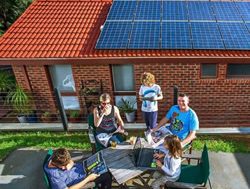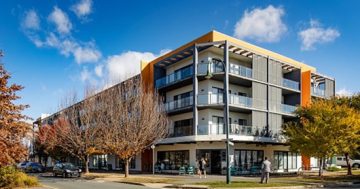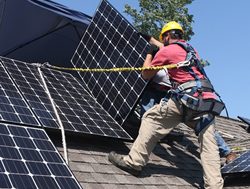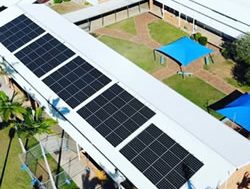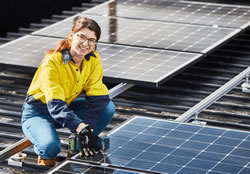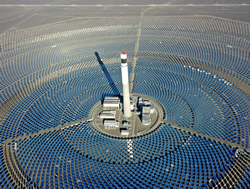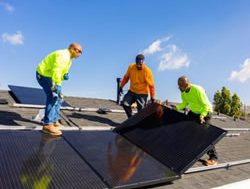James Purtill* says solar panel prices are tipped to fall after years of increases and discusses the best time to buy.
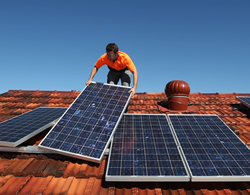 After an unprecedented period of increases, the wholesale price of solar panels is tipped to fall, with some experts predicting sizeable drops of 10 per cent per year for the next decade.
After an unprecedented period of increases, the wholesale price of solar panels is tipped to fall, with some experts predicting sizeable drops of 10 per cent per year for the next decade.
In 2020, the cost per watt of solar energy increased for the first time in decades, as manufacturing and shipping ran into the pandemic.
Now, it appears the long downwards trend in solar prices is set to resume.
Cheaper panels is good news for households looking to install solar, although there are a few large flies in the ointment, including increasing labour costs and waning government rebates.
Households that are ready to get solar now probably won’t save money by waiting.
Here’s why — and what’s driving the price decrease.
Why solar panel prices went up
the cost of solar systems began to rise in late 2021.
A standard-size 6.6-kilowatt system that had cost a bit over $5,000 in 2021 was priced an extra $1,000 a year later.
So, what was driving up prices?
Australia imports almost all of its solar panels from China.
One big cause of the price increase was the amount manufacturers in China were paying for polycrystalline silicon (polysilcon).
Polysilicon is a highly processed form of very pure silicon that’s used to make most of the world’s solar cells.
These cells are then assembled into solar panels, also known as modules, often at different plants.
Most of the world’s polysilicon is made in China.
From July 2020 to July 2022, the price of solar-grade polysilicon in China increased from $US7 per kilogram to $39 per kg.
So, what had made polysilicon so expensive?
The weather, partly.
In August 2020, floods forced one major polysilicon plant in China to stop production.
Two years later, a heatwave saw hydropower generation drop and electricity demand increase, leading authorities to order manufacturers to curb or shut down operations to conserve power.
There were also industrial accidents in this time: a series of explosions at different plants further constrained supply.
Renate Egan, a UNSW solar expert, said these floods and fires had a big effect on prices.
“Over the last three years, polysilicon prices have gone up due to these incidents,” she said.
COVID restrictions within China also caused supply chain problems, which drove the price up even further.
The price peaked in August 2022 at $US39 per kg ($55.87 per kg), and then fell by a third in six months to $US21 per kg.
In the first months of 2023 it rebounded, but Professor Egan said the long-term trend pointed downwards.
“There’s been a couple of big investments in polysilicon manufacturing and a couple of [these new manufacturing plants] are coming online, which is relieving the polysilicon supply problem,” she said.
“We’re optimistic we’ll see the volumes improve and the prices drop.”
How far will prices drop?
Tim Buckley, director of the Climate Energy Finance think tank, was the most bullish with his forecast.
“I’m forecasting 10 per cent annual module price reductions over the next decade,” he said.
“Module prices are falling — and the speed of the fall is accelerating.”
The reason for his confidence is the number of solar panel manufacturing facilities being built in China.
The existing global solar PV annual production capacity will triple by the end of the year, with most of the new capacity in China, according to a recent report.
Ronald Brakels, an analyst at Solar Quotes, another platform for comparing solar prices, predicted the “factory gate” price of solar panels made in China will eventually halve.
“These big polysilicon factories are supposedly profitable at a price of under $US10 per kg,” he said.
“The price of polysilicon can fall that low and that will roughly halve the cost of typical solar panel at the factory gate.”
Chris Williams, CEO of Natural Solar, a large solar installation company, was also optimistic.
He predicted the cost of panels could drop “10 to 12 per cent” this year, and about “3 to 5 per cent” per annum in following years.
“I expect to see more of that price reduction flow through over coming months,” he said.
“The caveat is that there’s always a supply shock or some strain somewhere.”
So cheaper panels is the good news.
The bad news is that the Australian households installing solar may not necessarily see these savings.
In fact, some industry observers say the retail cost may even go up.
Why the actual cost of solar may go up
This is where it gets complicated.
The price Australian households pay for rooftop solar is determined by more than the cost of modules in China.
Other factors include the relative strength of the Australian dollar, the cost of shipping and labour, and the value of government rebates.
“Module pricing is a small component of rooftop solar cost,” Professor Egan said.
“We might see a 10 per cent drop in module prices, but only a 2-3 per cent change in installation price.”
So, will this net installation cost go up or down?
Here, experts and industry observers were divided in their opinions.
Jeff Sykes, CEO of Solar Choice, said it was going up — and would probably stay up.
If he’s right, households will never again pay as little for an installed rooftop system as they did in late 2021.
“The cost of labour makes up 20-25 per cent of the cost of a solar system — and the cost of labour is increasing,” he said.
“We’re going to see continuing upward pressure on net system prices.”
Households are also getting less money back from the federal government.
The value of solar rebates is decreasing by a 15th (6.66 per cent) every year until it drops to zero in 2031.
Rami Fedda, co-founder of Solar Juice, a wholesale distributor of solar panels, also saw prices rising.
“We’ve hit the bottom — whatever you’re paying today, by next month our quotations for panels will go up.
“It could easily go up five per cent.”
Ronald Brakels from Solar Quotes said prices would fall, but not by much.
“To the average consumer, we’re only going to see a modest decline in solar prices,” he said.
‘Don’t wait for cheaper panels’
In summary, the wholesale cost of solar panels is trending down over the long-term, but when we look at what households pay for an installed rooftop system, it’s complicated.
There are also a few clouds on the horizon.
In January, the Chinese government said it was considering banning the export of technology used to make solar panels to help it maintain its dominance in solar manufacturing.
Such a ban would slow the push by the US and Europe to develop their own photovoltaics supply chains, which could drive up prices.
The war in Ukraine and the associated energy crisis in Europe is another variable.
Europe was hungry for solar panels, said Rami Fedda from Solar Juice.
“It’s going gangbusters at the moment — whatever product you can get into Europe is getting sold.”
If energy prices in Australia increase this winter like they did the last, demand for rooftop solar could go up, potentially driving up the cost of solar systems.
Given this uncertainty, most experts recommend not waiting for cheaper panels.
If a household is in a position to install panels now, and the house itself is suitable, they will save money from having reduced power bills this year, said Solar Quotes’s Ronald Brakels.
The saving will probably be greater than any potential reduction — if one occurs — in the cost of panels.
“They are very unlikely to come out ahead by waiting,” he said.
*James Purtill works at triple j Hack in Sydney.
This article first appeared at abc.net.au.

